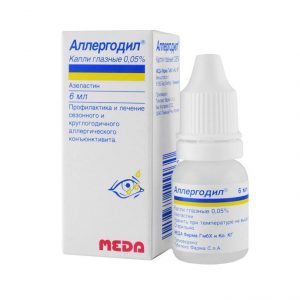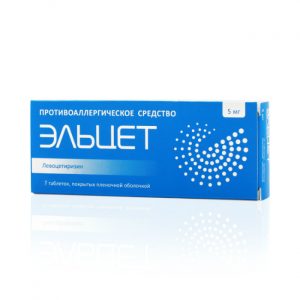Description
Pharmacological action
Cetirizine – the active substance of the drug – is a metabolite of hydroxyzine, belongs to the group of competitive histamine antagonists and blocks H1-histamine receptors.
In addition to the antihistamine effect, cetirizine prevents the development and facilitates the course of allergic reactions: at a dose of 10 mg once or twice a day, it inhibits the late phase of aggregation of eosinophils in the skin and conjunctiva of patients prone to atopy.
Clinical efficacy and safety Studies in healthy volunteers have shown that cetirizine in doses of 5 or 10 mg significantly inhibits the reaction in the form of a rash and redness to the introduction of high concentration of histamine into the skin, but there is no correlation with efficacy. In a 6-week placebo-controlled study involving 186 patients with allergic rhinitis and concomitant bronchial asthma of mild and moderate course, it was shown that taking cetirizine in a dose of 10 mg once a day reduces the symptoms of rhinitis and does not affect lung function.
The results of this study confirm the safety of cetirizine in patients with mild to moderate allergies and bronchial asthma. In a placebo-controlled study, it was shown that taking cetirizine at a dose of 60 mg per day for 7 days did not cause a clinically significant lengthening of the QT interval.
Taking cetirizine in the recommended dose showed an improvement in the quality of life of patients with year-round and seasonal allergic rhinitis. Children In a 35-day study involving patients aged 5-12 years, there were no signs of immunity to the antihistamine effect of cetirizine.
Normal skin reaction to histamine was restored within three days after drug withdrawal with its repeated use. In a 7-day, placebo-controlled study of the drug in the dosage form, syrup with the participation of 42 patients aged 6 to 11 months demonstrated the safety of the drug.
Cetirizine was administered at a dose of 0.25 mg / kg twice daily, which approximately corresponded to 4.5 mg per day (dose range ranged from 3.4 to 6.2 mg per day). Use in children from 6 to 12 months is possible only as directed by a doctor and under strict medical supervision.
Indications
The use of the drug is indicated in adults and children from 6 months of age and older to facilitate:
– nasal and ocular symptoms of perennial (persistent) and seasonal (intermittent) allergic rhinitis and allergic conjunctivitis: itching, sneezing, nasal congestion, rhinorrhea, lacrimation, conjunctival hyperemia
– symptoms of chronic idiopathic urticaria.
Use in children from 6 to 12 months is possible only as directed by a doctor and under strict medical supervision.
Contraindications
– Hypersensitivity to cetirizine, hydroxyzine or any piperazine derivative, as well as to other components of the drug.
– Terminal stage of renal failure (CC <10 ml / min). – Children under 6 months of age (due to limited data on the efficacy and safety of the drug). – Pregnancy. Precautions – Chronic renal failure (with KK> 10 ml / min, dosage adjustment is required).
– Elderly patients (with age-related decrease in glomerular filtration rate).
– Epilepsy and patients with increased convulsive readiness.
– Patients with predisposing factors for urinary retention (see section “Special instructions”).
– Children under 1 year old.
– The period of breastfeeding.
– When used simultaneously with alcohol
Directions for use
Inside, drip into a spoon or dissolve in water. The amount of water for dissolving the drug should correspond to the amount of fluid that the patient (especially the child) is able to swallow. The solution should be taken immediately after preparation. Adults 10 mg (20 drops) 1 time per day.
Elderly patients
There is no need to reduce dosage in elderly patients if renal function is not impaired.
Patients with renal failure Since cetirizine is excreted mainly by the kidneys, if alternative treatment is not possible for patients with renal failure, the dosage regimen of the drug should be adjusted depending on the function of the kidneys (CC value). CC for men can be calculated based on the concentration of serum creatinine in blood plasma, according to the following formula:
QC (ml / min) = [140 – age (years)] body weight (kg) / 72 KKserum (mg / dl)
KK for women can be calculated by multiplying the resulting value by a factor of 0.85.
Patients with impaired liver function
In patients with impaired hepatic function, dosage adjustment is not required. In patients with impaired liver function and kidney function, dosage adjustment is recommended.
Children
Use in children from 6 to 12 months is possible only as directed by a doctor and under strict medical supervision.
Children 6 to 12 months old 2.5 mg (5 drops) once daily
Children 1 year to 6 years old 2.5 mg (5 drops) 2 times daily
Children 6-12 years old 5 mg (10 drops) 2 times a day
Children over 12 years of age 10 mg (20 drops) 1 time per day
Sometimes an initial dose of 5 mg (10 drops) may be enough if this allows satisfactory control of symptoms.
In children with renal failure, the dose is adjusted taking into account QC and body weight.
If, after treatment, improvement does not occur or the symptoms worsen, or new symptoms appear, consult a doctor. Use the drug only according to the indications, the method of use and at the doses indicated in the instructions.
Special instructions
Due to the potential inhibitory effect on the central nervous system, caution should be exercised when prescribing the drug to children under 1 year of age in the presence of the following risk factors for sudden childhood death syndrome, such as (but not limited to): – apnea syndrome sleep or sudden infant death syndrome in infants of a brother or sister
– mother abuse drug or smoking during pregnancy
– young mother’s age (19 years and younger)
– abuse of smoking by a nanny caring for a child (one pack of cigarettes a day or more)
– children, regularly falling asleep face down and not laid on the back
– premature (gestational age less than 37 weeks) or born with insufficient 12 body weight (below the 10th percentile of the gestational age)
children – when taking drugs that have a depressing effect on the central nervous system.
The preparation contains excipients methyl parahydroxybenzoate and propyl parahydroxybenzoate, which can cause allergic reactions, including delayed type. In patients with spinal cord damage, prostatic hyperplasia, as well as in the presence of other predisposing factors for urinary retention, caution is required, since cetirizine may increase the risk of urinary retention. Caution is advised when using cetirizine simultaneously with alcohol. Caution should be observed in patients with epilepsy and increased convulsive readiness. Before prescribing allergological tests, a three-day ² Ñwashing ² Ñ period is recommended due to the fact that H1-histamine receptors inhibit the development of skin allergic reactions. After stopping the use of cetirizine, itching and / or urticaria may appear, even if these symptoms were absent at the beginning of treatment. In some cases, symptoms may be intense and may require cetirizine to resume. Symptoms disappear with the resumption of cetirizine.
Composition of
1 ml of the preparation contains:
Active ingredient:
Cetirizine dihydrochloride 10.0 mg
Excipients:
Propylene glycol 350.0 mg
Sodium glycerol anhydrous 250 mg 10 mg 0 mg
Sodium acetate trihydrate 10.0 mg
Methyl parahydroxybenzoate 1.35 mg
Propyl parahydroxybenzoate 0.15 mg
Glacial acetic acid up to pH 4.0 – 6.0
Water for injection up to 1.0 ml
Side effects of
Clinical trial data
review Clinical studies have shown that the use of cetirizine in recommended doses results in minor adverse effects on the central nervous system (CNS), including drowsiness, fatigue, dizziness and headache.
In some cases, paradoxical CNS stimulation has been reported. Despite the fact that cetirizine is a selective blocker of peripheral H1 receptors and practically does not have an anticholinergic effect, isolated cases of difficulty urinating, accommodation disturbances and dry mouth have been reported.
Abnormal liver function has been reported, accompanied by increased levels of liver enzymes and bilirubin. In most cases, adverse events resolved after cetirizine was discontinued.
List of adverse reactions There is evidence from a double-blind, controlled clinical trial to compare cetirizine and placebo, or other antihistamines,ina) in more than 3200 patients, on the basis of which a reliable analysis of safety data can be carried out.
Overdose
Symptoms
With normal renal function, an overdose of magnesium when taken orally does not usually lead to toxic reactions. However, in case of renal failure, magnesium poisoning may develop.
Overdose symptoms, the severity of which depends on the concentration of magnesium in the blood: decreased blood pressure, nausea, vomiting, depression of the central nervous system, decreased reflexes of changes on the electrocardiogram, respiratory depression, coma, cardiac arrest and respiratory paralysis anuric syndrome.
Treatment
Rehydration, forced diuresis. In renal failure, hemodialysis or peritoneal dialysis is necessary.fatigue, headache, malaise, mydriasis, itching, anxiety, weakness, sedation, drowsiness, stupor, tachycardia, tremor, urinary retention.
Treatment
Immediately after taking the drug, gastric lavage or vomiting stimulation. It is recommended to take activated charcoal, symptomatic and supportive therapy. There is no specific antidote. Hemodialysis is ineffective.
Storage conditions
Store at a temperature not exceeding 25 ° C. Keep out of the reach of children.
Expiration
3 years. After opening the bottle – 6 months. Do not use after expiration date!
Conditions of sale from
pharmacies Without a prescription




